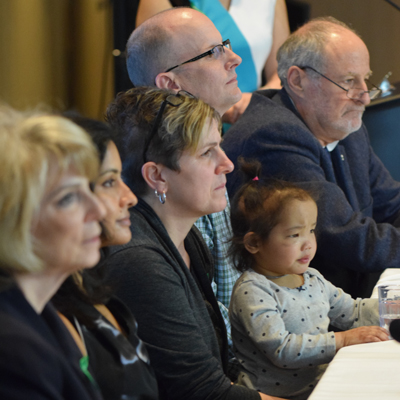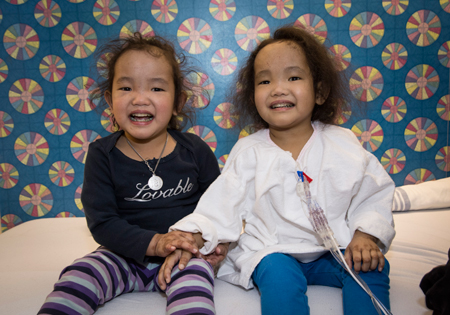
Michael Wagner (C), who donated a portion of his liver to daughter, Phuoc, 3, (F) in February, is all smiles flanked by his wife, Johanne Wagner (L), and Dr. Gary Levy (R), Director of Living Donor Liver Program at Toronto General Hospital, UHN, at a news conference Tuesday announcing Phuoc’s twin sister, Binh, is doing well following a living donor transplant from an anonymous donor. (Photo: UHN)
Just six days after her life-saving liver transplant, still attached to multiple monitoring and medication tubes, three-year-old Binh took a few steps on wobbly legs.
Holding her mother's hand, her feet in pink slippers, she was able to make it to a weight scale and back to her bed.
"We can do a few little steps," cooed her mother, "Good job, Binhie Bear."
A relieved mom, Johanne Wagner, posted on Facebook this week that her daughter had received a life-saving transplant from an anonymous living donor. She is recovering "well" and is expected to make an "excellent" recovery.
SickKids and Toronto General Hospital announced the successful transplant at a news conference Tuesday, while being careful not to divulge the date of the surgery nor any other potentially identifying factors.

(L to R) Ronnie Gavsie, President and CEO, Trillium Gift of Life Network, Dr. Binita Kamath, Staff Hepatologist in the Transplant and Regenerative Medicine Centre, SickKids, Johanne Wagner, twins' mom, Phuoc, 3, and Michael Wagner, twins' dad, and Dr. Gary Levy (R), Director of Living Donor Liver Program at TGH, UHN, at a news conference Tuesday announcing Phuoc's twin sister, Binh, is doing well following a living donor transplant from an anonymous donor. (Photo: UHN)
Both parents were teary-eyed as they thanked the anonymous donor who saved their daughter's life.
"I would like to say to the anonymous donor that you were in my thoughts as much as my daughter," said Johanne. "I could look up at the window of Toronto General Hospital from across the street at SickKids and send you my positive wishes and thoughts several times a day. Thank you for what you have done for Binh."
Johanne also emphasized that not everyone waiting for an organ has a living donor organ option. "We need organs from deceased donors too. Organ donation saves lives. It works."
The media conference took place during National Organ and Tissue Donation Awareness Week - a time to thank those who have given the gift, or registered to do so, and encourage others to sign-up at beadonor.ca.

Phuoc Wagner (L), 3, and her twin sister, Binh, smile for the camera during a visit to The Hospital for Sick Children, where Binh is recovering after receiving a living donor liver transplant from an anonymous donor. (Photo: SickKids Hospital)
Michael Wagner, the father of Binh, and the living liver donor of Binh's twin sister, Phuoc, choked with emotion as he thanked the "incredibly brave" donor. "This is someone who put their life on the line for someone they will never meet." He added that he would like to continue to be an advocate for organ donation, as there are still many children and adults waiting for an organ. "The organs exist. We can make a big difference to those waiting for that phone to ring, letting them know that there is an organ for them."
Michael donated about 20 per cent of his liver to Phuoc in a six-hour living donor procedure at TGH on February 10, 2015. Almost all of his liver will regenerate within 12 weeks, and the portion of his liver transplanted into Phuoc will grow with her. Both are now at home, doing well.
The Facebook story of both twins needing transplants with their dad being able to donate to only one child touched the hearts of people around the world. Almost two years old when adopted from Vietnam, they weighed about nine pounds each. In Canada, they were diagnosed with Alagille syndrome, a genetic disorder that attacks the liver and other organs.
More than 500 people stepped up to be considered as potential donors for Binh, some from as far away as Spain, South America and New Zealand. Because of Binh's age, doctors focused on a donor who is less than 50 years old, in good health (a Body Mass Index below 25), a compatible blood type of A or O, and, for logistical reasons, who lives in Ontario.
So far, two other recipients have benefitted from transplants from this donor pool, tests for two other donors have been completed and they are ready to donate, and four others have expressed an interest in donating anonymously.
TGH has the largest living liver donor program in North America performing more than 60 living liver donor transplants a year (both adult and pediatric). There is a 15 per cent survival advantage for those who undergo live liver donation in comparison to those who wait for a deceased donor organ, since about 35 per cent of deceased donor organs are less than ideal.
Dr. Gary Levy, head of the living liver donor program at TGH, said that Binh's living donor is now at home and doing "extremely well….That person sends greetings and love to the Wagner family and the twins."
Levy praised living donors, who are willing to risk a procedure they do not need in order to save a life. "I admire these brave people who are willing to give selflessly to someone who they will never meet. It's inspiring. And although our program excels in ensuring donors and recipients are safe and well cared for, we still need to emphasize that deceased donation is an important aspect of organ donation."
In Ontario, about 1,500 people are waiting for an organ at any time, with a person dying every three days while waiting. Only 26 per cent of Ontarians have registered to donate their organ at the end of their lives.
